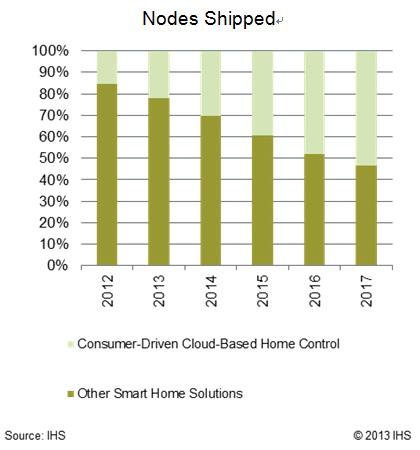According to the latest study from analyst firm IHS, more than 300 million smart home gateways and nodes (such as smart thermostats and connected lighting devices) will be shipped within the next five years.
A smart home is one that features interconnected, intelligent devices which form a network to enable home automation, remote home control, and/or interactive home systems, enabling functions such as home security, energy management, and/or comfort and convenience. According to the latest study from analyst firm IHS, more than 300 million smart home gateways and nodes (such as smart thermostats and connected lighting devices) will be shipped within the next five years.
There are many different smart home system types that range from standard home automation systems to demand-response devices, which communicate with smart electricity meters to enable demand-response or peak load shedding, reducing the energy consumed by devices such as appliances or HVAC systems when the total grid-wide electricity demand is at its highest. However, it is cloud-based remote home management systems which are set to drive the highest growth over the coming years. These systems allow consumers not only to automate devices to create scenarios (such as reducing the temperature when the security system is set) but also control or monitor devices via a smartphone, tablet or other Internet-enabled device when consumers are away from the home. Applications can range from turning lights on at home when a consumer leaves the office, to receiving notifications when children return home from school, to viewing remotely a feed from a network camera if an intruder alarm is triggered.
 One of the main driving forces behind the cloud-based home control segment is the growing involvement of existing service providers — such as telecommunication, TV and alarm-monitoring service providers — moving heavily into this market as an extension to their current offerings. Such companies are well-suited to provide these services to consumers, and often enter the market as a means of reducing customer churn and increasing average revenue per user by offering a home management starter-pack of devices, with an associated monthly fee for the cloud-based service element of the system.
One of the main driving forces behind the cloud-based home control segment is the growing involvement of existing service providers — such as telecommunication, TV and alarm-monitoring service providers — moving heavily into this market as an extension to their current offerings. Such companies are well-suited to provide these services to consumers, and often enter the market as a means of reducing customer churn and increasing average revenue per user by offering a home management starter-pack of devices, with an associated monthly fee for the cloud-based service element of the system.
Much of the initial activity in this market has been driven by companies in North America, with a range of service providers — such as ADT, Comcast and Verizon — offering cloud-based home management solutions. For the North American market, the initial service is often based around home monitoring, with devices such as magnetic contacts (to alert users if a window or door is opened while the system is set to “Away” mode), motion sensors and even door locks. According to the latest research from IHS, revenues from only those devices sold as part of emerging smart home systems are projected to grow from more than US$100 million in 2012 to more than US$600 million in 2017, with the service element representing additional revenue opportunity.
The growing interest in cloud-based home management systems has significant implications for device vendors. In a recent consumer survey from IHS, which had respondents from the U.S., Brazil, the U.K., Germany and China, more than two thirds of the respondents indicated that they would consider purchasing connected versions of devices, such as intruder alarms, the next time they needed to replace their existing devices.
While home-monitoring solutions are often used as a means of selling the initial smart home service into a household, providers can then up-sell with add-on hardware and services to enable further functionality, such as lighting or HVAC control. As the ecosystem continues to develop, the emerging smart home presents a major opportunity for hardware, software and service providers alike, to create new, sustainable revenue streams from an increasingly connected customer base.